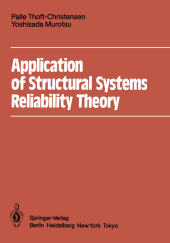 Neuerscheinungen 2011Stand: 2020-01-07 |
Schnellsuche
ISBN/Stichwort/Autor
|
Herderstraße 10
10625 Berlin
Tel.: 030 315 714 16
Fax 030 315 714 14
info@buchspektrum.de |

Yoshisada Murotsu, Palle Thoft-Christensen
(Beteiligte)
Application of Structural Systems Reliability Theory
Softcover reprint of the original 1st ed. 1986. 2011. viii, 343 S. 244 mm
Verlag/Jahr: SPRINGER, BERLIN 2011
ISBN: 3-642-82766-7 (3642827667)
Neue ISBN: 978-3-642-82766-2 (9783642827662)
Preis und Lieferzeit: Bitte klicken
During the last two decades more and more universities offer courses on modern structural reliability theory. A course on structural reliability theory is now a natural part of the curri culum for mechanical and structural engineering students. As a result of this, a number of textbooks have been published in this decade. In PlOst of these books it is shown how the reliability of single structural members can be evaluated in a rational way. The methods used are usually so-called level 2 methods, i. e. methods involving certain approximate iter ative calculations to obtain an approximate value of the probability of failure of the struc tural members. In these methods the joint probability distribution of relevant variables (re sistance variables, loads, etc. ) is simplified and the failure criteria are idealized in such a way that the reliability calculations can be performed without an unreasonable amount of work. In spite of the approximations and idealizations made it is believed that a rational treatment of uncertainties in structural engineering can be obtained by level 2 methods. Usually, in sufficient data are at hand to make a more advanced estimate of the reliability of a struc tural member. It has been recognized for many years that a fully satisfactory estimate of the reliability of a structure must be based on a systems approach. In some situations it is sufficient to estimate the reliability of the individual structural members of a structural system.
1. Fundamentals of Structural Reliability Theory.- 1.1 Introduction.- 1.2 Modelling of Load and Resistance Variables.- 1.3 The Fundamental Case.- 1.4 Basic Variables and Failure Surfaces.- 1.5 The Hasofer and Lind Reliability Index.- 1.6 Estimate of the Reliability of Single Elements.- 1.7 Non-Normal Basic Variables.- 2. Modelling of Structural Systems.- 2.1 Introduction.- 2.2 Modelling of Structural Elements.- 2.3 Fundamental Systems.- 2.4 Systems Modelling At Level N.- 2.5 Systems Modelling at Mechanism Level.- 2.6 Formal Representation of Systems.- 2.7 Approximations of the Multivariate Normal Distribution Function.- 3. Reliability of Series Systems.- 3.1 Introduction.- 3.2 Probability of Failure of Series Systems.- 3.3 Reliability Bounds for Series Systems.- 3.4 Series Systems with Equally Corelated Elements.- 3.5 Series Systems with Unequally Correlated Elements.- 3.6 The Hohenbichler Approximation.- 4. Reliability of Parallel Systems.- 4.1 Introduction.- 4.2 Probability of Failure of Parallel Systems.- 4.3 Reliability Bounds for Parallel Systems.- 4.4 Equivalent Linear Safety Margins for Parallel Systems.- 4.5 Parallel Systems with Equally Correlated Elements.- 4.6 Parallel Systems with Unequally Correlated Elements.- 5. Automatic Generation of Safety Margins.- 5.1 Introduction.- 5.2 Generation of Safety Margins for Truss Structures.- 5.3 Generation of Safety Margins for Frame Structures Subjected to Single Load Effect.- 5.4 Generation of Safety Margins for Frame Structures Subjected to Combined Load Effects.- 5.5 Generation of Fundamental Mechanisms for Elastoplastic Structures.- 6. Reliability Analysis of Structural Systems by the ?-Unzipping Method.- 6.1 Introduction.- 6.2 Non-Normal Basic Variables.- 6.3 Reliability of Single Elements.- 6.4 Estimate of Systems Reliability at Level 1.- 6.5 Estimate of Systems Reliability at Level 2.- 6.6 Estimate of Systems Reliability at Level N 2.- 6.7 Estimate of Systems Reliability at Mechanism Level.- 7. The Branch-and-Bound Method.- 7.1 Introduction.- 7.2 Failure Paths and Failure Modes.- 7.3 The Concept of the Branch-and-Bound Method.- 7.4 Identification of Dominant Failure Paths.- 7.5 Evaluation of the Systems Reliability.- 7.6 Application to Offshore Structures.- 7.7 Further Developments and Numerical Examples.- 8. Optimization of Structural Systems.- 8.1 Introduction.- 8.2 Probability-Based Optimum Design Problem.- 8.3 Various Problems of Probability-Based Optimum Design.- 8.4 Optimum Design Based on Element Reliability.- 8.5 Optimal Design by The ?-Unzipping Method.- Appendix the Standard Normal Distribution Function c.


